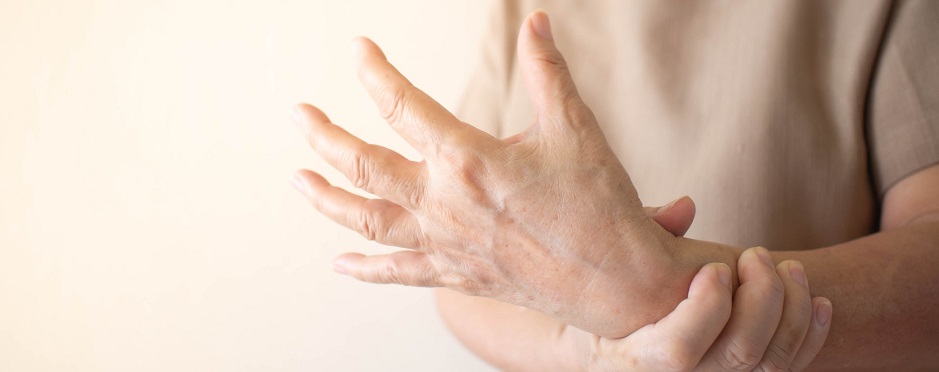
What’s this Bump on My Wrist?
Leave a CommentIf you experience a lump on your wrist, it may seem very concerning. More than likely however, there is little need for concern. The potential cause of the lump on your wrist is something called a ganglion cyst. In this blog, we’ll discuss what a ganglion cyst is and what it isn’t, who it affects, and how it can be treated.
What is a ganglion cyst?
A ganglion is a fluid-filled lump below the surface of the skin. The fluid in the cyst is a jelly-like consistency. These benign (non-cancerous) masses form near a joint or tendon within the body’s soft tissues. They often do not cause any symptoms and sometimes disappear with no treatment. They can vary in size from very small ones that cannot be felt, up to 2.5 cm.1,2,3,4
What causes ganglion cysts, and who is affected?
The cause of ganglion cysts is not known. It is theorized that a cyst may develop after a micro-injury or with overuse, which allows the tissue to leak or bulge out. They often will become larger as the joint is used more repetitively. Women are three times more likely to develop ganglion than men. Most people who develop ganglion cysts are between 20-50 years of age. Having a previous injury or having arthritis can also make you more likely to develop ganglion cysts.1,2,3,4
How is a ganglion cyst diagnosed?
A healthcare provider can usually diagnose the ganglia by physical examination. They may feel the cyst or perform an ultrasound to determine if the cyst is solid or filled with liquid. An x-ray may be taken to rule out additional concerns. Sometimes, a ganglion cyst can be hidden, meaning it is between bones, often carpal bones within the wrist. This makes it hard to observe the lump on the surface of the skin. Ganglion cysts can cause pain and may limit motion. Anti-inflammatory medications may be prescribed to decrease discomfort.2,3,4
What is the treatment for a ganglion cyst?
Ganglion cysts are typically painless, and your healthcare practitioner may choose to monitor the cyst and provide no further treatment if it is not causing any pain or concern. If the cyst is causing pain, tingling, numbness, weakness, limiting motion, or if there is a cosmetic concern, treatment is recommended. The first line of treatment is often aspiration. During aspiration treatment, the fluid is drained from the lump using a syringe with a needle. This, however, does not guarantee that the cyst will not return since this does not get rid of the cyst entirely. In fact, there is up to a 50% chance that the cyst can return. Injecting cortisone after aspiration decreases the likelihood of occurrence.3 The fluid that is aspirated can be sent to a lab for further analysis.
When is surgery needed?
Should the lump continue to reoccur and cause pain, tingling, or numbness and limit motion, surgical intervention may be recommended. The goal of surgery is to remove the entire cyst. Ganglions often have a stalk-like structure or root attached to the cyst, which is what allows them to refill or reoccur. Surgery can be performed through an open technique but is often performed through a scope with a tiny camera. This is called a ganglionectomy and is usually an outpatient procedure, which means you would go home the same day. Full recovery is typically two to six weeks following this procedure. Having the cyst surgically removed can reduce the risk of a cyst coming back, but they do reoccur in an estimated 5 to 15% of cases.2
Meet with an Athletico Hand Therapist
Ultimately, ganglion cysts do not pose a serious threat to your health and can be monitored as they may go away without treatment. If they are affecting your quality of life, several treatment interventions are available to provide relief of symptoms.2 Should you have questions about ganglion cysts or other conditions of the wrist or hand, our hand therapists at Athletico are available to help. Get started today by scheduling a free assessment where our experts can help determine which course of treatment is best for you.
The Athletico blog is an educational resource written by Athletico employees. Athletico bloggers are licensed professionals who abide by the code of ethics outlined by their respective professional associations. The content published in blog posts represents the opinion of the individual author based on their expertise and experience. The content provided in this blog is for informational purposes only, does not constitute medical advice and should not be relied on for making personal health decisions.
References:
1 “Ganglion Cyst.” Mayo Clinic, Mayo Foundation for Medical Education and Research, 30 Dec. 2020, www.mayoclinic.org/diseases-conditions/ganglion-cyst/symptoms-causes/syc-20351156#:~:text=Ganglion%20cysts%20are%20lumps%20that,in%20the%20ankles%20and%20feet.
2 “Ganglion Cysts: Causes, Symptoms, Diagnosis & Treatment.” Cleveland Clinic, my.clevelandclinic.org/health/diseases/15554-ganglion-cysts.
3 Masci, Lorenzo. “Aspiration of Ganglion Cyst: Is It Worth It?” Sport Doctor London, 15 Apr. 2021, sportdoctorlondon.com/aspiration-of-ganglion-cyst/.
4 “Wrist or Hand Tumor: Signs & Treatment: The Hand Society.” Signs & Treatment | The Hand Society, 2015, www.assh.org/handcare/condition/wrist-hand-tumor.
